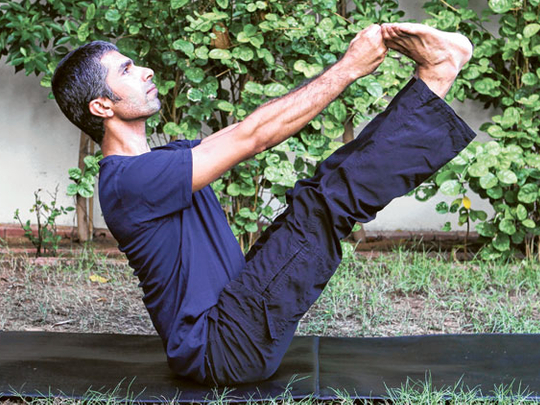
Today, we will take a look at Utthita Hasta Merudandasana, or the raised hand and spine pose.
Often while practising balancing postures, one rests either on legs or arms. However, the Utthita Hasta Merudandansana is one of the few postures in which the practitioner focuses on maintaining balance on an entirely different body part when the tail bone becomes a fulcrum, or the point of support.
Utthita Hasta Merudandasana
- Sit with back straight and legs together, outstretched in front.
- Bend the knees, keep feet together and place them flat on the floor, and close to the buttocks. Hold big toes with each hand. Slowly lean backward.
- Raise feet off the floor without releasing toes. Keep knees bent while trying to find your balance on the coccyx (commonly referred as the tail bone).
- Without losing your balance, straighten the arms and legs and keep them in the centre. Hold this final position, focusing your gaze on a fixed point ahead of you. You may keep your awareness on the stretch of the arms, legs and/or on maintaining balance.
- To come out of the posture, exhale and lower feet slowly back on the floor.
- Practise up to five rounds, holding the breath in the final position for as long as comfortable. If you choose to hold the pose for some time, breathe normally.
Benefits
- This posture tones the abdominal organs and strengthens the abdominal muscles.
- It helps alleviate constipation by stimulating intestinal peristalsis.
- It strengthens the muscles of the back and helps to realign the spine.
- It is beneficial for the feet and legs, giving them a feeling of lightness and balance.
Caution
People suffering from high blood pressure, heart ailments, slipped disc or sciatica should avoid this pose.
Bharat Thakur guides you through practices that will connect you to the wisdom of the ancient Indian science of exercising.











